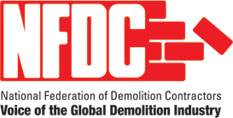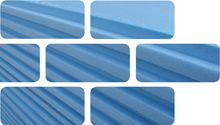
Boards and Blocks Containing HBCDD Insulation 17 06 04
Hexabromocyclododecane (HBCD or HBCDD) is a brominated flame retardant included in the manufacture of some expanded polystyrene (EPS) and extruded polystyrene (XPS) insulation foam boards and blocks since the 1970s. HBCDD can also be found in some upholstered furniture and electric and electronic equipment. Regulations derived from the Stockholm Convention and the 1998 POPs Protocols (enacted via REACH) will require safe disposal of materials containing HBCDD from 2015. It is believed that approximately 40% of all EPS and XPS insulation boards and blocks used in construction since the 1970s contained HBCDD, manufactured in a wide range of styles, sizes, colours and thicknesses that are commonly unmarked and will be difficult to visually identify. Boards and blocks containing HBCDD may be bound to other product to form a composite or panel system and may include a vapour barrier foil or an architectural face e.g. vinyl. Testing of all rigid insulation boards and blocks may be necessary in the future to determine which ones contain HBCDD. The disposal route for materials containing HBCDD will most likely be through incineration or in a hazardous landfill. NFDC is advising Defra on the challenges and costs of controlled, selective and forensic deconstruction of boards and blocks containing HBCDD and the growing volumes that will arise over the next fifty years.
Usage & Probable Locations
Insulation boards and blocks containing HBCDD were mostly used for insulating cavity walls, floors, ceilings and stud walls, but also used as an insulating layer in panels, structural insulated panels, cladding of commercial and industrial buildings, civil engineering applications, road embankments, blocks in beam-and-block floors and insulated plasterboard (see other DRIDS). Insulation boards and blocks are commonly found within the roof, rafters, ceilings, cavity walls, gable ends, stud walls, in panels, under/above/within suspended floors, under/above concrete floor slabs and in some civil engineering applications, bridges and embankments.
Personal Protective Equipment
PPE requirements indicated are for guidance purposes only. DRIDS has identified the PPE that is mandatory on all demolition projects and ones that may be required subject to site specific Risk Assessment & Method Statement (RAMS). Hover over the icon to determine the types of PPE required for the removal of this material.
Removal, Segregation & Storage
Insulation boards and blocks containing HBCDD that arise from demolition and refurbishment activities will not in the future be suitable for reuse or recycling. They will need to be segregated from other insulation boards and blocks not containing HBCDD and sent for safe disposal. The current position of UK Government is that materials and products containing HBCDD should not be reused or recycled, but eliminated through incineration or disposal in a hazardous landfill. Cost and viability may require that all insulated boards and blocks recovered on a project are sent for incineration. The current practice of landfilling boards and blocks containing HBCDD in a normal landfill will most likely be stopped. Partial pulverisation of boards and blocks containing HBCDD during demolition practice and processes will most likely be stopped.
Tools
Fixtures, Fittings & Connections
Boards and blocks containing HBCDD have been traditionally fixed in place with nails or underneath roofing sheets with screws or drive nails. For cavity walls, inbetween trusses or above/below/inbetween suspended and concrete floors, the insulated boards and blocks will be tightly run between timber or concrete joists or just laid in place over, under or within the suspended floor or concrete slab. Structural insulated panels and thermal laminated boards containing plasterboard, rigid insulation and vapour barrier foil that are bound together with adhesives will be difficult to separate before incineration or disposal in a hazardous landfill.
Health & Safety
Subject to task-specific Risk Assessment & Method Statement (RAMS). Use correct protective equipment for removing fixings, especially nails and screws. Wear gloves when handling boards or panels with damaged edges, coated in vapour barrier foil or decorative film to prevent irritation, cuts and friction burns. Wear eye protection when removing nails or screws with a crowbar, hammer or nailbar. Do not walk on wet and slippery boards or panels. Wear mask when removing or breaking insulation boards or blocks to prevent inhalation or ingestion of dust. Do not walk on insulation boards between joists.













